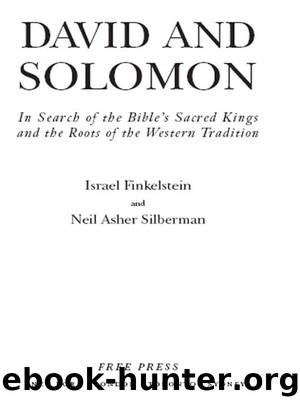David and Solomon: In Search of the Bible's Sacred Kings and the Roots of the Western Tradition by Finkelstein Israel & Silberman Neil Asher

Author:Finkelstein, Israel & Silberman, Neil Asher [Finkelstein, Israel]
Language: eng
Format: epub, azw3
Publisher: Free Press
Published: 2007-04-03T00:00:00+00:00
CREATING THE SOLOMONIC MYTH
The stories of Solomon in the Bible are uniquely cosmopolitan. Foreign leaders are not enemies to be conquered or tyrants to be suffered; they are equals with whom to deal politely, if cleverly, to achieve commercial success. The biblical tales of Solomon’s dealings with Hiram of Tyre and the queen of Sheba are literary acts of self-promotion—in trade negotiations, in diplomatic relations, in the status of the king. Solomon’s legend, first put into writing in the seventh century BCE, asserts Judah’s greatness—and the essential skill of its monarch—in the brave new world of trade and cross-cultural communication of the Assyrian empire.
In ruling, administering, trading, and wisely judging his people, Solomon is presented as an ideal leader on the model of the Assyrian king: “And men came from all peoples to hear the wisdom of Solomon, and from all the kings of the earth, who had heard of his wisdom” (1 Kings 4:34). “Thus King Solomon excelled all the kings of the earth in riches and wisdom. And the whole earth sought the presence of Solomon to hear his wisdom” (1 Kings 10:23–24). Even the extent of territory ruled by Solomon—in one version, from the Euphrates to Gaza (1 Kings 4:24)—reflects a vision of Assyrian kingship as the ultimate ideal. Though the dating of this verse is uncertain, the territory described is roughly equivalent to the western territories ruled by the Assyrian kings in the late eighth and seventh centuries BCE.
Closer to home, the Solomonic legend expresses nostalgia for the achievements of the fallen kingdom of Israel. Another description of the extent of Solomon’s kingdom—from Dan to Beer-sheba (1 Kings 4:25)—actually fits the borders of Judah and Israel combined. While the stories of David were used to refute the accusations of the northerners, the image of Solomon borrows heavily from northern royal traditions—not refuting them but rather adopting them and depicting him as equal or even superior to the most powerful north Israelite kings. Just as they sailed the high seas in search of treasure; just as they traded in thoroughbred horses; just as they attracted the interest of the far-off Arabian kingdoms, so our cherished founding father Solomon had done on an even more massive and lucrative scale. Thus in addition to merging the cherished memories of the Israelites within the southern kingdom with the prestige of the Davidic dynasty, the Solomonic narratives were used to legitimize for all of Judah’s people the aristocratic culture and commercial concerns of the court of Manasseh that promoted Judah’s participation in the Assyrian world economy.
The Bible’s composite vision of Solomon’s wisdom, commerce, and far-flung international connections has filled a thousand church windows and illustrated Bibles for centuries. While David was a man of war, Solomon was the prince of peace through diplomacy and trade. Solomon’s image promises security, stability, and happiness in a world in which boundaries are fluid and national glory is achieved through wisdom and commercial acumen.
Yet the circumstances that gave birth to this vision were not to last forever.
Download
David and Solomon: In Search of the Bible's Sacred Kings and the Roots of the Western Tradition by Finkelstein Israel & Silberman Neil Asher.azw3
This site does not store any files on its server. We only index and link to content provided by other sites. Please contact the content providers to delete copyright contents if any and email us, we'll remove relevant links or contents immediately.
| Buddhism | Christianity |
| Ethnic & Tribal | General |
| Hinduism | Islam |
| Judaism | New Age, Mythology & Occult |
| Religion, Politics & State |
Cecilia; Or, Memoirs of an Heiress — Volume 1 by Fanny Burney(31341)
Cecilia; Or, Memoirs of an Heiress — Volume 3 by Fanny Burney(30938)
Cecilia; Or, Memoirs of an Heiress — Volume 2 by Fanny Burney(30894)
The Secret History by Donna Tartt(16643)
Sapiens: A Brief History of Humankind by Yuval Noah Harari(13067)
Leonardo da Vinci by Walter Isaacson(11912)
The Radium Girls by Kate Moore(10914)
Sapiens by Yuval Noah Harari(4546)
The Wind in My Hair by Masih Alinejad(4427)
How Democracies Die by Steven Levitsky & Daniel Ziblatt(4407)
Homo Deus: A Brief History of Tomorrow by Yuval Noah Harari(4287)
Endurance: Shackleton's Incredible Voyage by Alfred Lansing(3852)
The Silk Roads by Peter Frankopan(3769)
Man's Search for Meaning by Viktor Frankl(3644)
Millionaire: The Philanderer, Gambler, and Duelist Who Invented Modern Finance by Janet Gleeson(3574)
The Rape of Nanking by Iris Chang(3522)
Hitler in Los Angeles by Steven J. Ross(3443)
The Motorcycle Diaries by Ernesto Che Guevara(3340)
Joan of Arc by Mary Gordon(3262)
